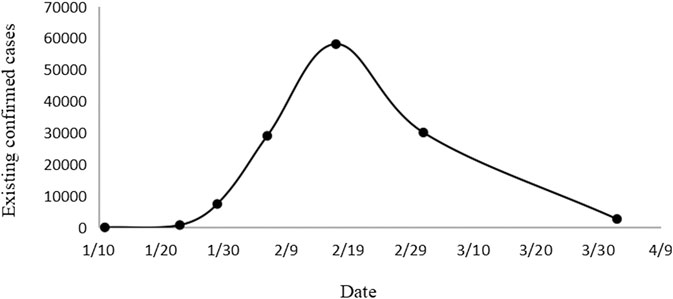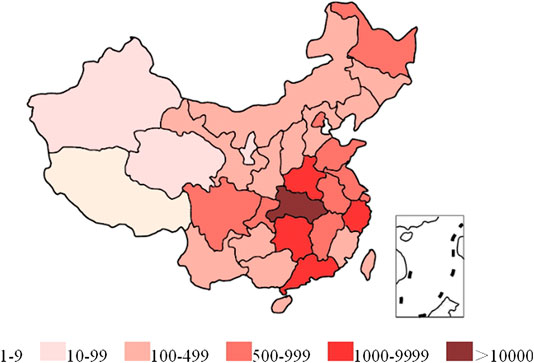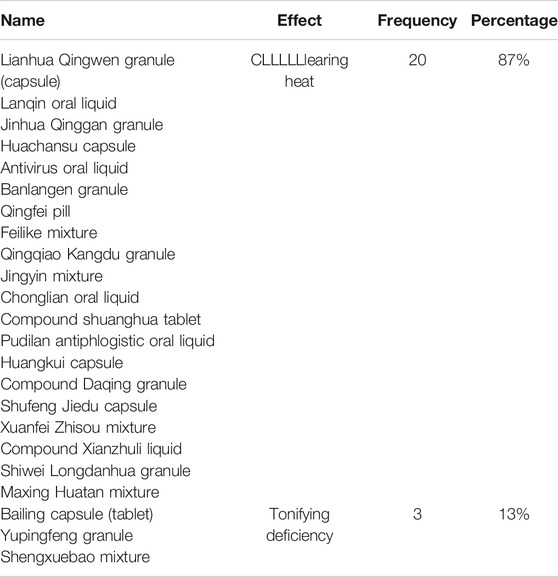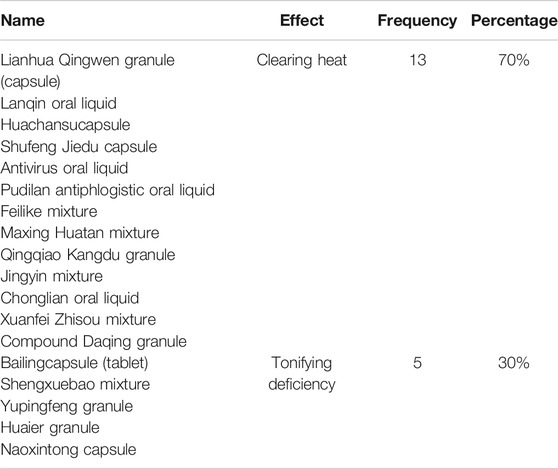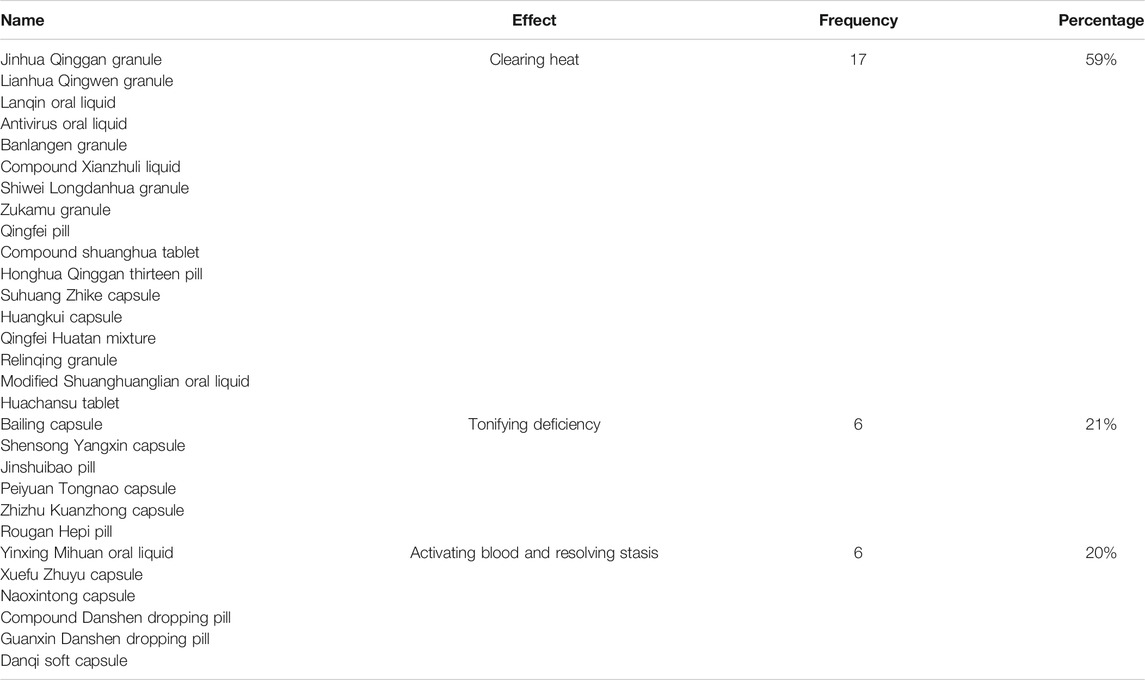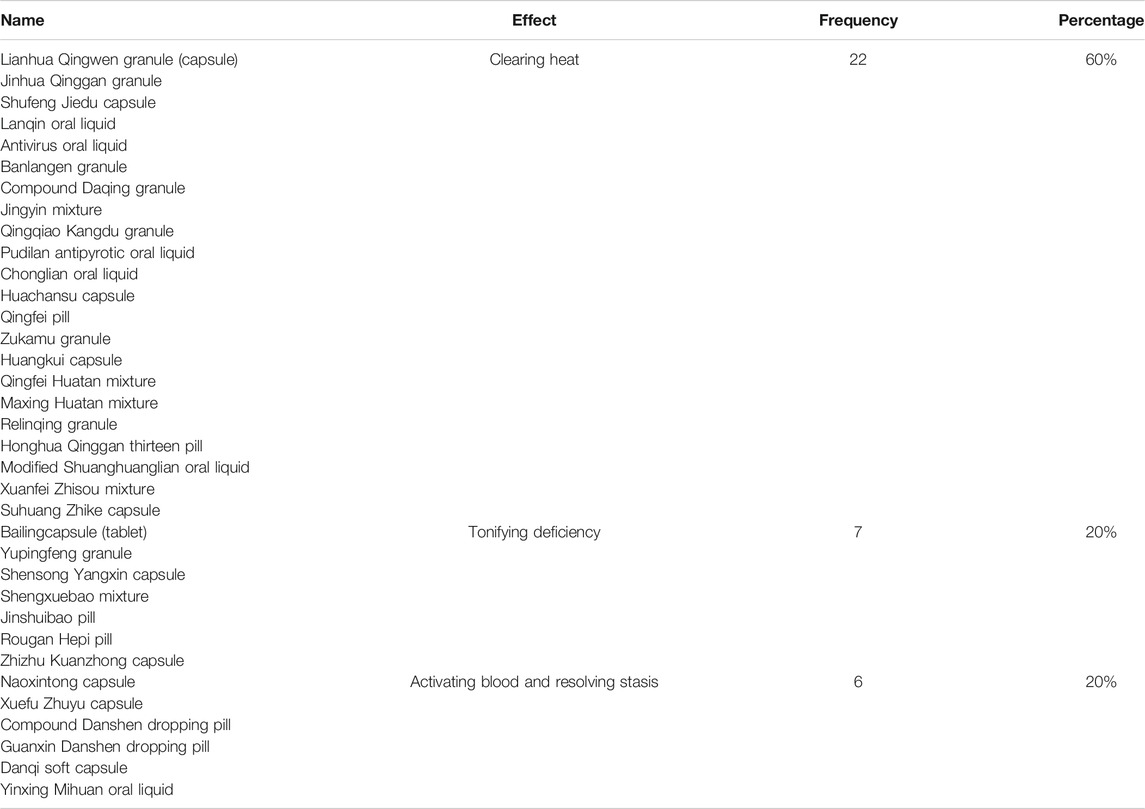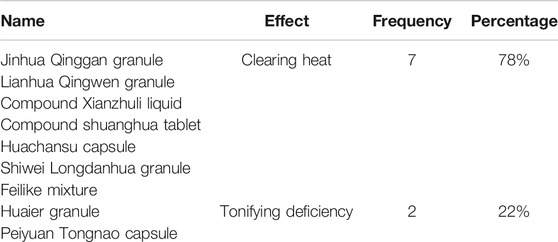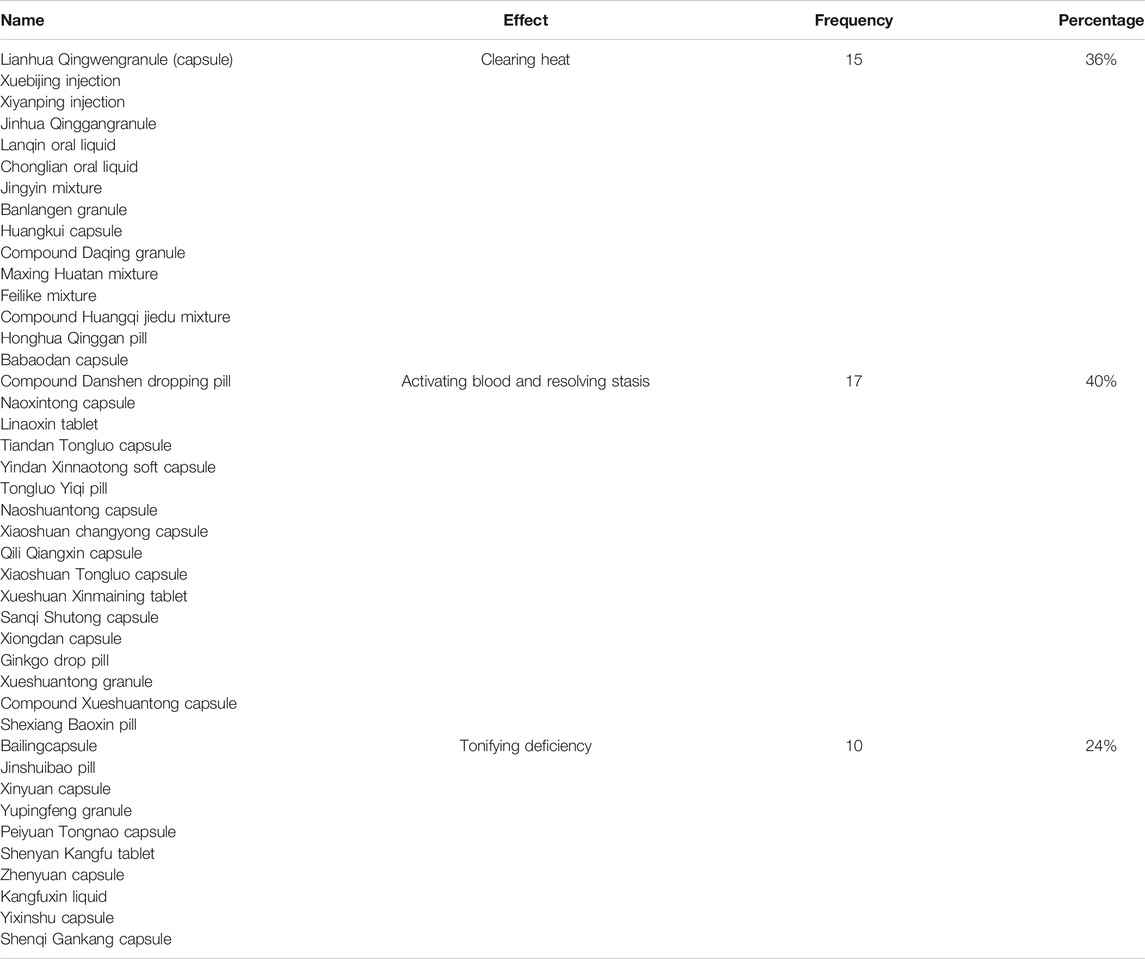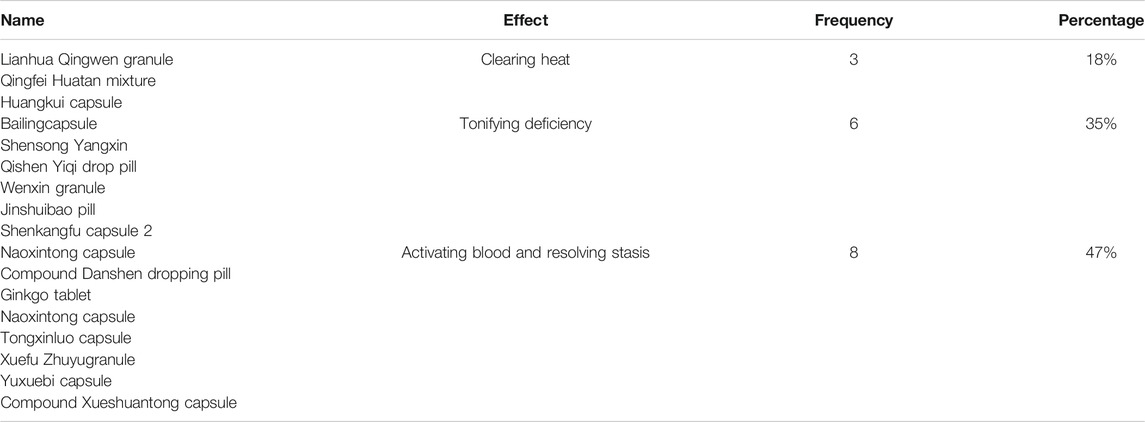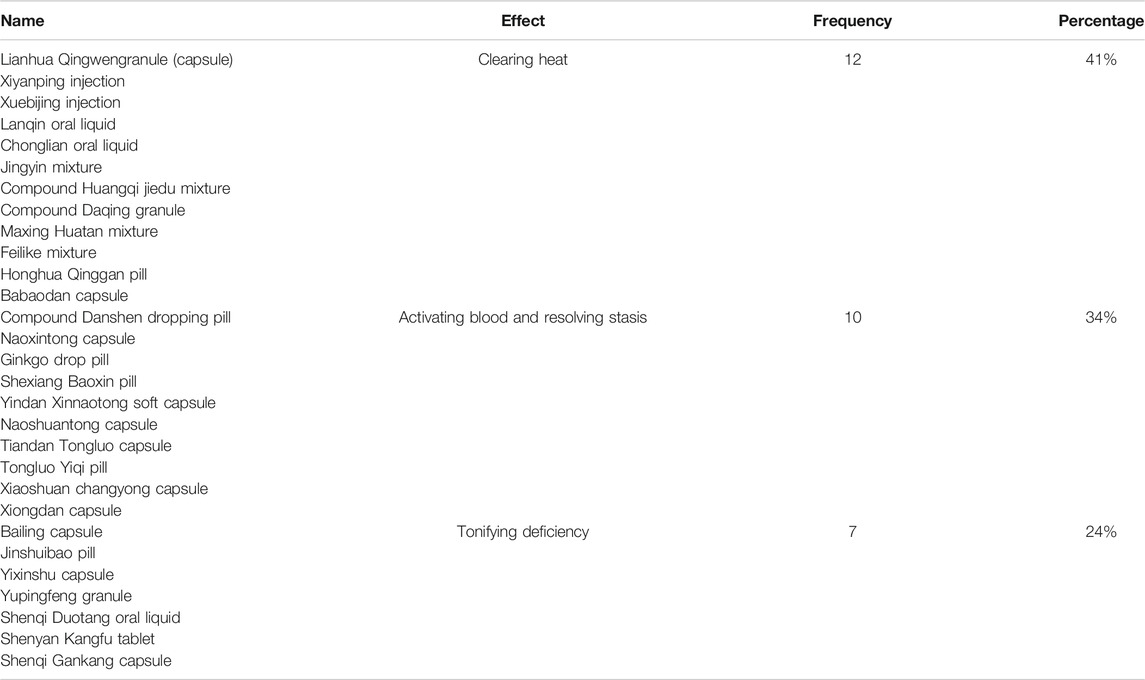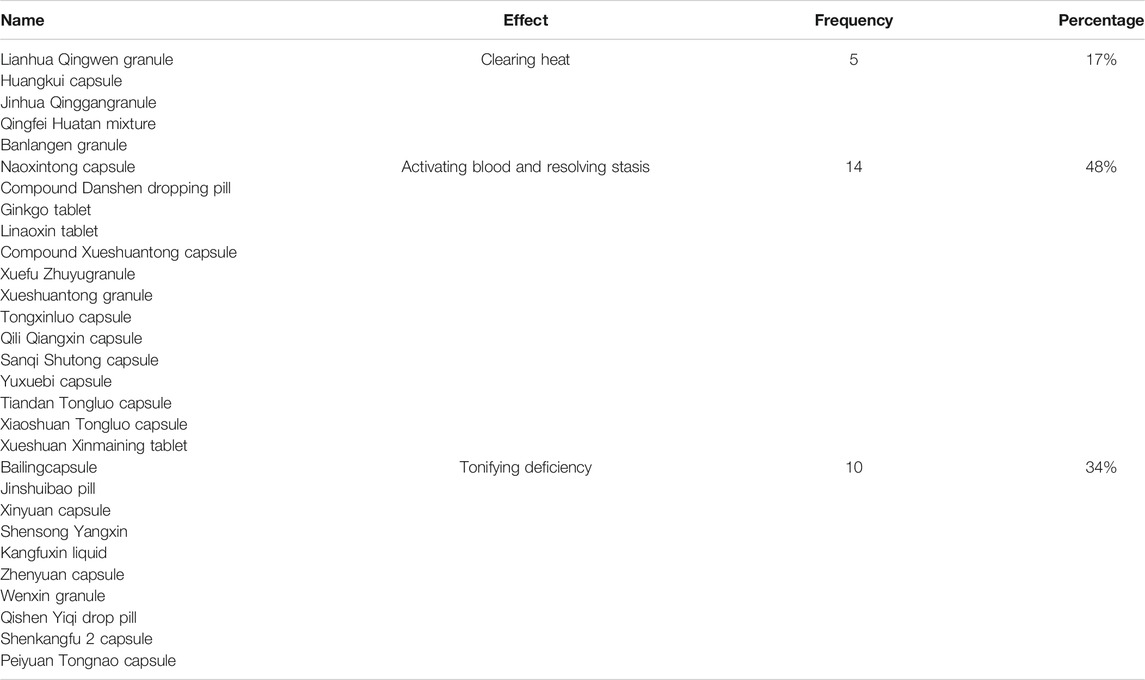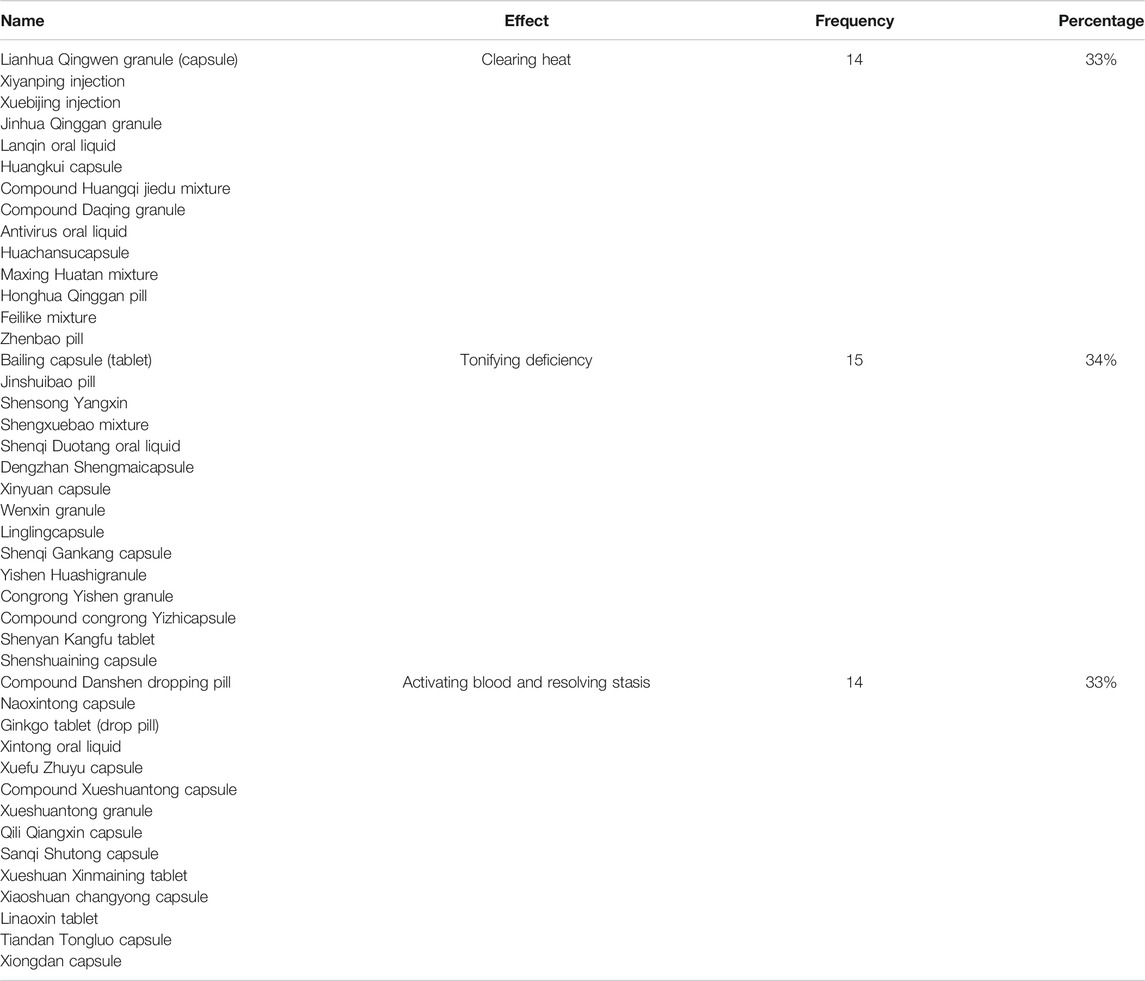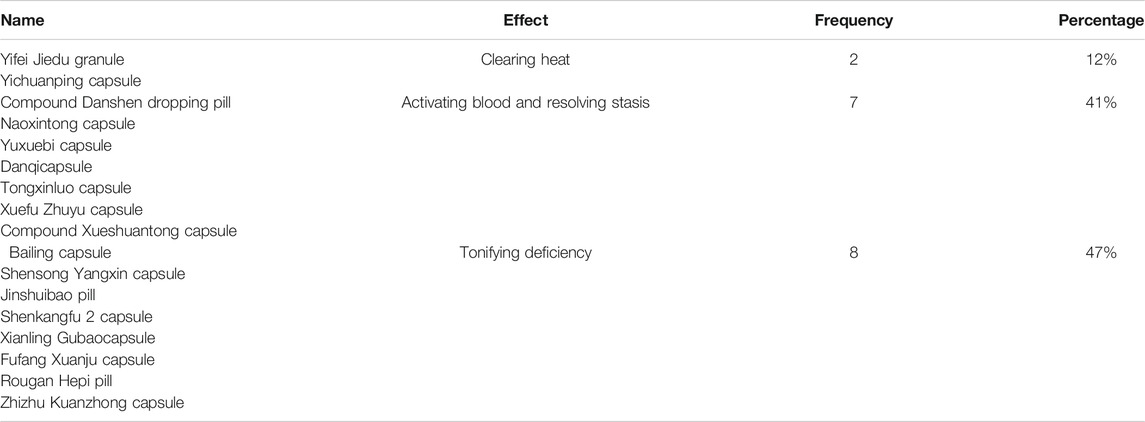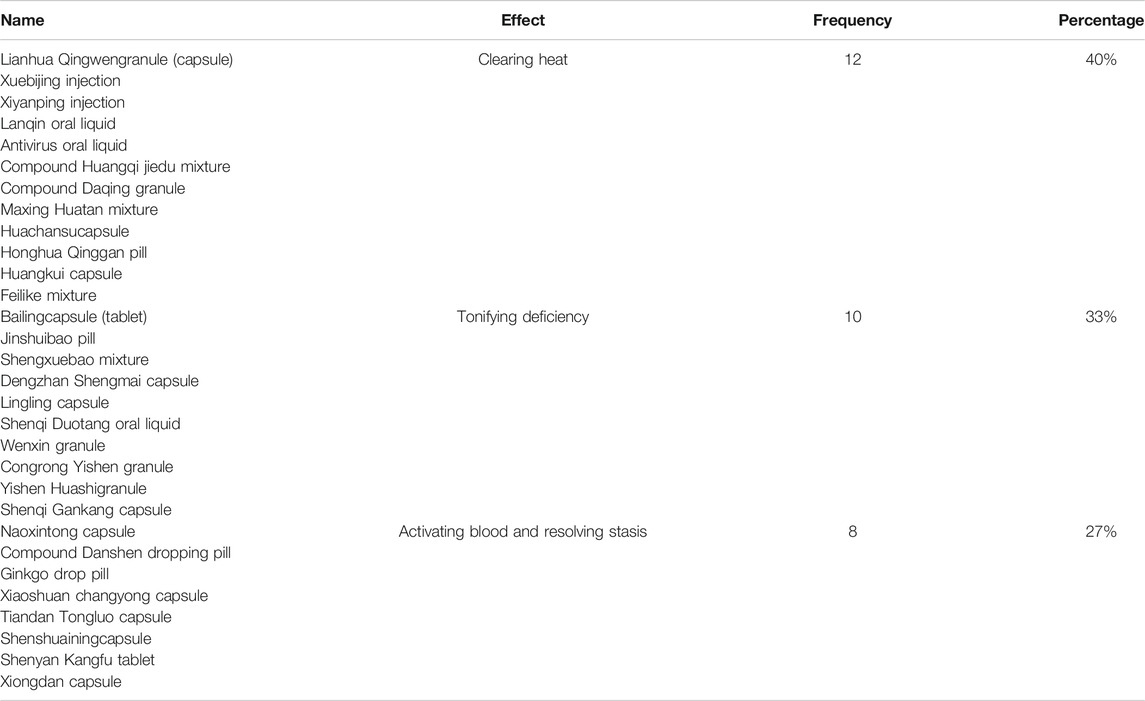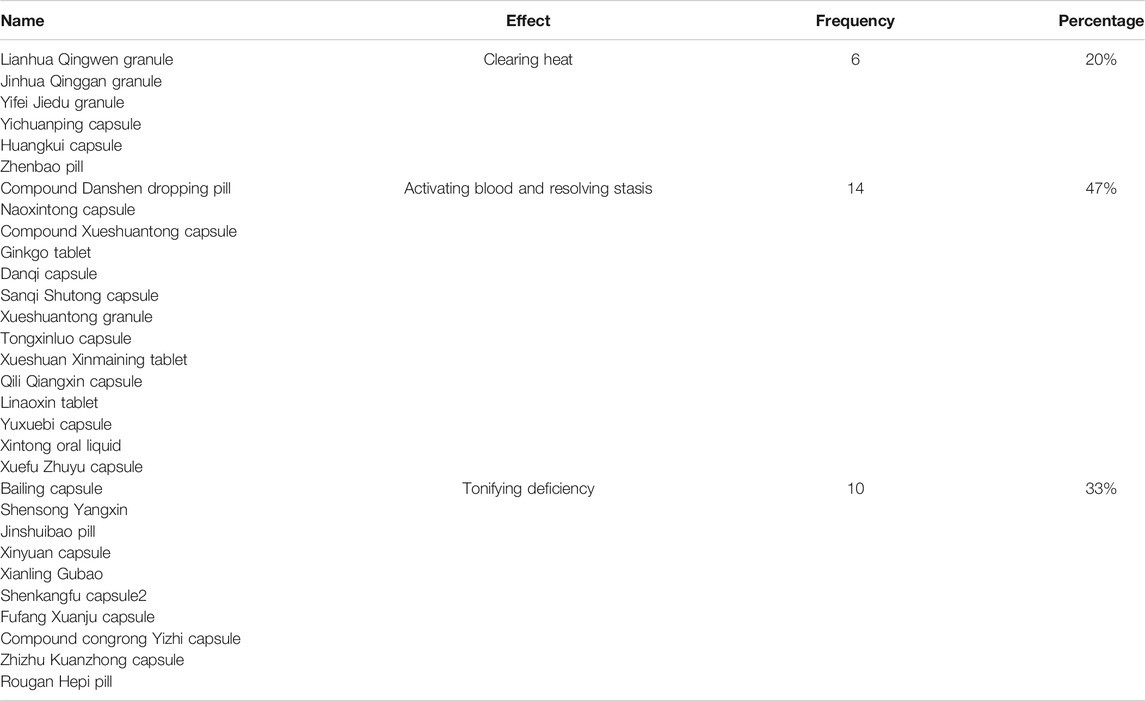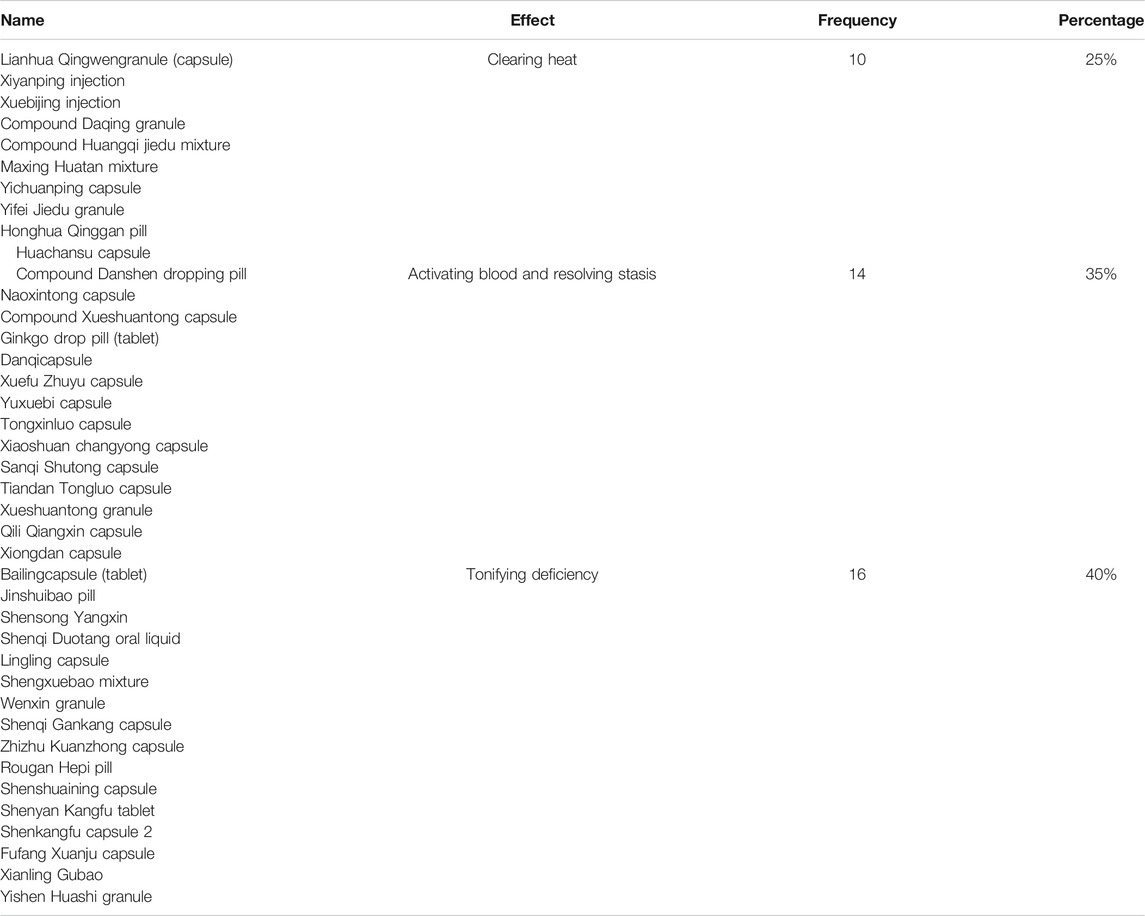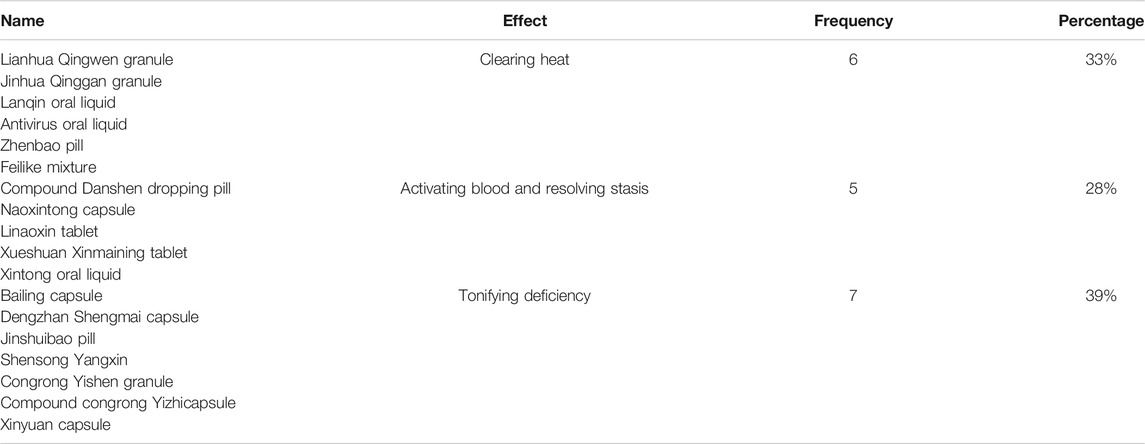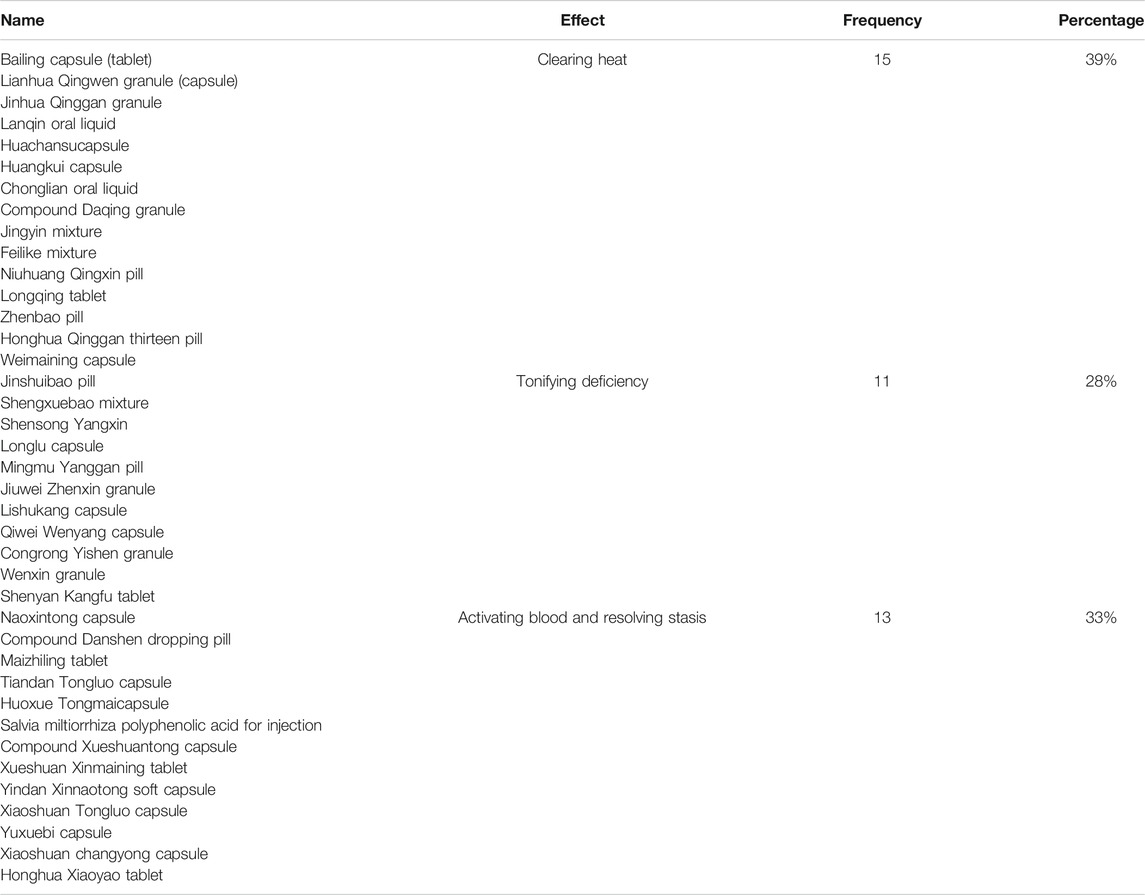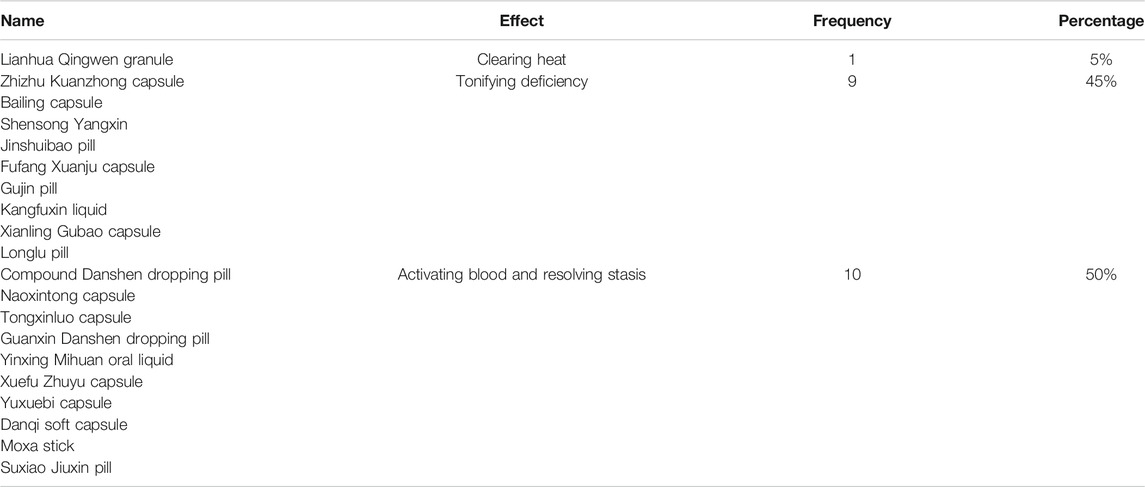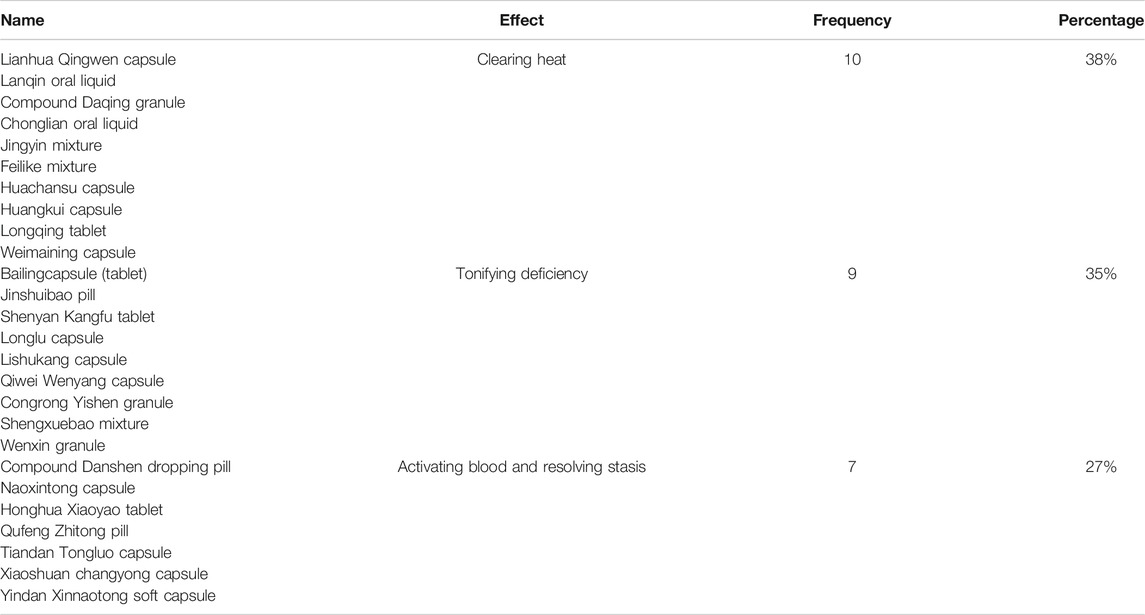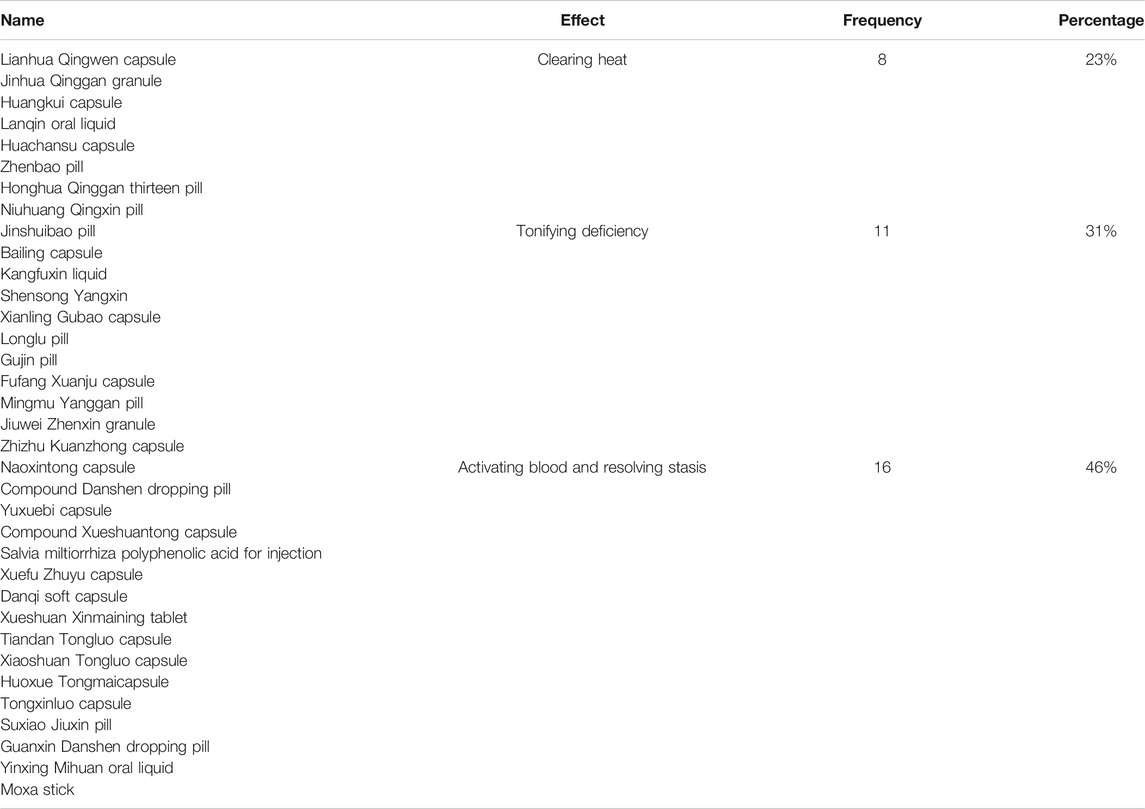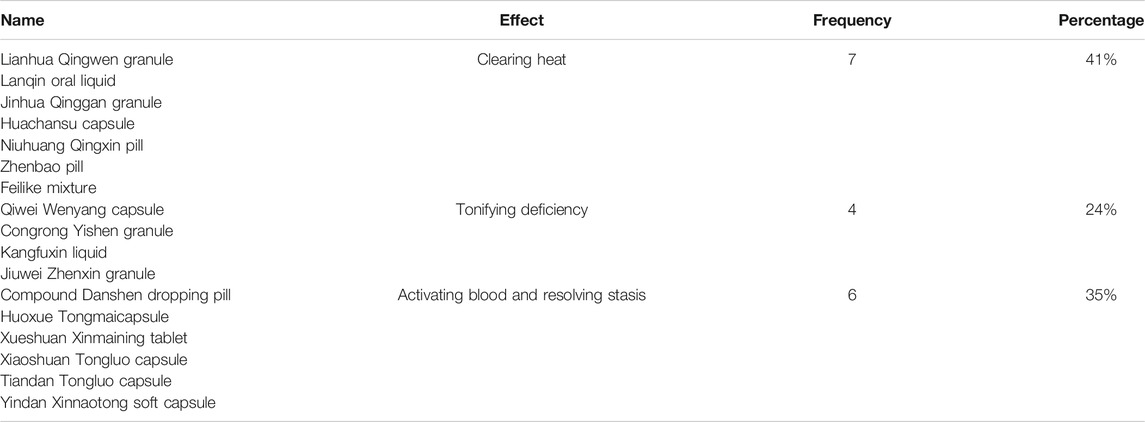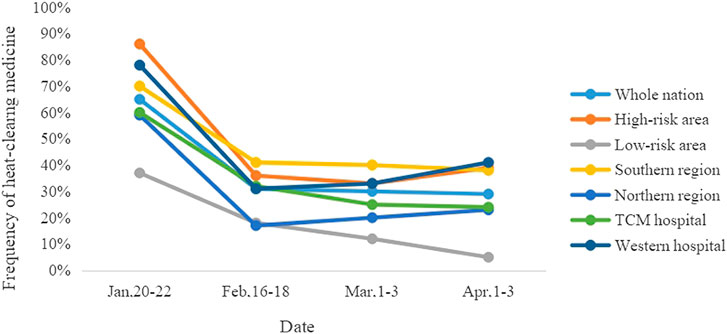Erratum: A Retrospective Study on the Use of Chinese Patent Medicine in 24 Medical Institutions for COVID-19 in China
- 1Beijing University of Traditional Chinese Medicine, Beijing, China
- 2China Academy of Chinese Medical Sciences, Beijing, China
- 3Shanghai Jiao Tong University Affiliated Sixth People’s Hospital, Shanghai, China
- 4Hospital of Chengdu University of Traditional Chinese Medicine, Sichuan, China
- 5Integrated Hospital of Traditional Chinese Medicine, Southern Medical University, Guangdong, China
- 6Beijing University of Chinese Medicine Third Affiliated Hospital, Beijing, China
- 7Beijing Hospital, Beijing, China
- 8Shenzhen People’s Hospital, Guangdong, China
- 9Traditional Chinese Medicine Hospital of Urumqi, Xinjiang, China
- 10Zhejiang Provincial Hospital of Traditional Chinese Medicine, Zhejiang, China
- 11Eye Hospital, China Academy of Traditional Chinese Medicine, Beijing, China
- 12The First Affiliated Hospital of Anhui University of Traditional Chinese Medicine, Anhui, China
- 13Shaanxi Provincial Hospital of Traditional Chinese Medicine, Shaanxi, China
- 14Beijing Hospital of Traditional Chinese Medicine, Capital Medical University, Beijing, China
- 15Xuanwu Hospital of Capital Medical University, Beijing, China
- 16Yueyang Hospital of Integrated Traditional Chinese and Western Medicine, Shanghai University of Traditional Chinese Medicine, Shanghai, China
- 17Affiliated Hospital of Shanxi University of Traditional Chinese Medicine, Shanxi, China
- 18The Second Affiliated Hospital of Changchun University of Chinese Medicine, Jilin, China
- 19First Teaching Hospital of Tianjin University of Traditional Chinese Medicine, Tianjin, China
- 20Gansu Provincial Hospital of Traditional Chinese Medicine, Gansu, China
- 21Affiliated Hospital of Jiangxi University of Traditional Chinese Medicine, Jiangxi, China
- 22Peking University Third Hospital, Beijing, China
- 23Shuguang Hospital Affiliated to Shanghai University of Traditional Chinese Medicine, Shanghai, China
- 24Beijing Shijitan Hospital, Capital Medical University, Beijing, China
- 25The Second Affiliated Hospital of Anhui University of Traditional Chinese Medicine, Anhui, China
Objective: This research aims to analyze the application regularity of Chinese patent medicine during the COVID-19 epidemic by collecting the names of the top three Chinese patent medicines used by 24 hospitals in 14 provinces of China in four time periods (January 20–22, February 16–18, March 01–03, April 01–03, 2020), and explore its contribution to combating the disease.
Methods: 1) We built a database of the top three Chinese patent medicines used by 24 hospitals. 2) The frequency and efficacy distribution of Chinese patent medicine were analyzed with risk areas, regions, and hospitals of different properties as three factors. 3) Finally, we analyzed the differences in the use of heat-clearing and non-heat-clearing medicines among the three factors (χ2 test) and the correlation between the Chinese patent medicine and COVID-19 epidemic (correlation analysis) with SPSS 23.0 statistical software.
Results: 1) The heat-clearing medicine was the main use category nationwide during January 20–22, 2020. Meanwhile, there was a significant difference in the utilization rate of heat-clearing and non-heat-clearing medicine in different risk areas (p < 0.01). 2) The variety of Chinese patent medicine was increased nationwide during February 16–18, 2020, mainly including tonics, blood-activating and resolving-stasis, and heat-clearing medicines. Meanwhile, there was a significant difference in the utilization rate of heat-clearing and non-heat-clearing medicine in the southern and northern regions (p < 0.05). 3) Tonics, and blood-activating and resolving-stasis medicines became the primary use categories nationwide during March 01–03, 2020. 4) The tonics class, and blood-activating and resolving-stasis medicine were still the primary categories nationwide during April 01–03, 2020. Meanwhile, there was a significant difference in the utilization rate of heat-clearing and non-heat-clearing medicine in different risk areas (p < 0.01).
Conclusion: Chinese patent medicine has a certain degree of participation in fighting against the COVID-19. The efficacy distribution is related to the risk area, region, and hospital of different properties, among which the risk area is the main influencing factor. It is hoped that future research can further collect the application amount of Chinese patent medicine used in hospitals all over the country, so as to perfectly reflect the relationship between Chinese patent medicine and the epidemic situation.
Introduction
COVID-19 is a contagious respiratory disease caused by severe acute respiratory syndrome coronavirus 2 (SARS‐CoV‐2), which was named by the coronavirus study group of the International Committee on Taxonomy of Viruses on February 11, 2020 (Sun et al., 2020). Currently, this epidemic disease has spread all around the world. The number of cumulative confirmed cases and existing confirmed cases in the countries except for China still show a continuous growth trend (World Health Organization, 2020), so the global pandemic remains severe.
From the Western Han Dynasty to the late Qing Dynasty, there were at least 321 large plagues in Chinese history. Therefore, Chinese history also contains a history of traditional Chinese medicine (TCM) against plagues. Faced with the SARS in 2003, China set up two independent “TCM Zone”, which achieved favorable results with the combination of Chinese and Western treatment. In the face of the COVID-19 pandemic, there is still a lack of effective drugs in the world. COVID-19 meeting of the Central Committee of China’s Leading Group request: strengthen the integration of TCM and western medicine, promote the whole process of the deep intervention of TCM diagnosis and treatment, and extend the effective TCM prescription and Chinese patent medicine (Wang et al., 2020).
There are four main aspects of TCM’s participation in the fight against COVID-19 (Zhang, 2020). First, providing TCM decoction to four quarantined groups of people, such as suspected and confirmed cases. Second, establishing Fangcang hospital, where nearly 10,000 patients almost entirely use TCM, and the coverage rate reached 95%. Third, for severe and critical patients, TCM also played an auxiliary role in improving oxygenation level and suppressing inflammatory factor storms. Finally, promoting recovery and reducing sequelae. TCM can remove residual evil, support vital qi, promote the absorption of pulmonary inflammation, and improve immune function. The proportion of TCM participating in the treatment of Hubei related hospitals was more than 2/3. The clinical practice data showed that the treatment of COVID-19 with integrated TCM and western medicine is effective (Yuan et al., 2020). TCM has shown remarkable effects in relieving fever symptoms, controlling disease progression, preventing disease transmissibility, reducing hormone dosage, decreasing complications, and preventing drug resistance (Chen et al., 2020).
The most obvious changes in the “sixth Trial Version of the Guidelines for the Diagnosis and Treatment of COVID-19” and later versions issued by the National Health Commission of China are the increased proportion of TCM therapeutic regimen, and the recommendation of Chinese patent medicine in different courses of COVID-19, especially the usage of TCM injections used for severe and critical patients. Twelve Chinese patent medicines are recommended for use in different stages of COVID-19 in the “seventh Trial Version of the Guidelines for the Diagnosis and Treatment of COVID-19” (National Health Commission National Administration of Traditional Chinese Medicine, 2020). Some studies have shown that Chinese patent medicines can significantly reduce the clinical manifestations of COVID-19 and play their pharmacological role in various mechanisms (Wang et al., 2020b; Zhang et al., 2020b).
This research aims to investigate the use of Chinese patent medicines used by 24 third-grade class-A hospitals in 14 provinces or cities of China during the epidemic from January to April, and analyze the usage characteristics, so as to have an in-depth understanding of the Chinese patent medicines’ participation and the related factors affecting its usage during the COVID-19 epidemic.
Materials and Methods
Data Sources
Data of the name of Chinese patent medicine ranked top three used in 24 third-grade class-A hospitals in four time periods were collected. The four periods are January 20–22, February 16–18, March 01–03, April 01–03, 2020. The 24 hospitals are distributed in 14 provinces or cities of China (Beijing, Tianjin, Jilin Province, Shanxi Province, Shaanxi Province, Gansu Province, Xinjiang Province, Hubei Province, Zhejiang Province, Guangzhou Province, Anhui Province, Shanghai Province, Jiangxi Province, Sichuan Province). The above four time points are distributed in the initial stage, the highest peak, the fastest decline stage, and the end-stage, respectively, of the curve of the existing confirmed cases of the COVID-19 in China, aiming to fully reflect the drug use in all stages (Figure 1).
Statistical Analysis
Data were analyzed with SPSS 23.0 statistical software. Chi-square (χ2) test was conducted when analyzing the difference of three factors in the frequency of heat-clearing and non-heat-clearing medicine. Regression analysis was taken when exploring the correlation between three factors and the epidemic situation. To avoid the influence of the uneven data on the analysis results, the frequency is weighted according to the proportion of the hospital with different properties when analyzing the hospital factor. Values of p < 0.05 and p < 0.01 were considered statistically significant differences and extremely significant differences separately.
Exclusion Criteria
(1) Specialist medicines;
(2) The medicines with an obscure name.
Medicines with the same ingredient but different dosage forms are considered to be the same type.
Classification Criteria of Three Factors
Risk area classification criteria: Risk regions were divided into high-risk areas (cumulative confirmed cases >500) and low-risk areas (cumulative confirmed cases <500). According to the distribution of COVID-19 up to April 14, 2020, China was divided into six levels according to the accumulated confirmed cases (as shown in Figure 2). We select the median 500 as the boundary of the high and low-risk areas based on the severity of the epidemic at that time.
Region classification criteria: According to the south or north of the Qinling Mountain-Huaihe River Line, the areas within the statistical scope are divided into the southern region and the northern region. Qinling Mountain-Huaihe River line is currently recognized as China’s north-south geographical boundary. There were many differences on both sides of this line in the natural conditions, agricultural production, geographical features, and people’s living customs (Sheng, 2008).
Hospital classification criteria: According to the official website of the hospitals and the management system of the National Administration of TCM, 24 hospitals are divided into traditional Chinese medical hospitals (TCM hospitals) and Western medical hospitals (note: integrative medicine hospitals are included in TCM hospitals for their same TCM treatment department setting).
Related Concepts
(1) TCM includes Chinese medicinal decoction pieces/TCM decoction and Chinese patent medicine.
(2) Chinese patent medicine is a kind of TCM product which is processed into a certain dosage form according to the prescription and preparation technology under the guidance of TCM theory and in order to prevent and treat diseases.
(3) Heat-clearing medicine: The properties of heat-clearing medicine is cold, whcih can clear the body’s internal heat, including heat-clearing and detoxifying medicines, heat-clearing and fire-purging medicines, heat-clearing and damp-drying medicines, heat-clearing and blood-cooling medicines, et al.
Non-heat clearing medicine: The main function of non-heat clearing medicine is not to clear away heat, in this article refers to the tonifying deficiency medicines or activating blood and resolving stasis medicines.
Results
Data Statistics for January 20–22, 2020
Nationwide Data Statistics
The data of 24 hospitals nationwide were summarized and the name of Chinese patent medicines with a frequency of more than one was obtained. Among them, the top three Chinese medicines were Lianhua Qingwen granule (capsule), Lanqin oral liquid, and Jinhua Qinggan granule. It was shown that the medicine for clearing heat and removing toxicity is the main use category in the whole country from January 20 to January 22 (specific data is shown in Supplementary Table S1).
Data Statistics of Different Risk Areas
The usage frequency of Chinese patent medicine in high-risk and low-risk areas was counted (specific data is shown in Supplementary Tables S2, S3), respectively, and the distribution regularities of efficacy were analyzed (Tables 1, 2). By comparing the high-risk and low-risk areas, it can be seen that the high-risk areas are concentrated in heat-clearing medicines with a frequency as high as 86%, while the heat-clearing drugs accounting for only 37%. The analysis results showed that the usage frequency of heat-clearing medicines and non-heat-clearing medicines was significantly different between high-risk and low-risk areas (p < 0.01, Table 7). Therefore, the higher the risk level of the epidemic situation, the stronger the pertinence of drug types to the disease.
Data Statistics of Different Regions
The usage frequency of Chinese patent medicine in southern and northern regions was counted (specific data is shown in Supplementary Tables S4, S5), respectively, and the distribution regularities of efficacy were analyzed (Table 3, 4). By comparing the northern region and southern region, it can be seen that the efficacy of Chinese patent medicines used in the southern region is relatively concentrated, with heat-clearing drugs (70%) as the main type, while the efficacy of Chinese patent medicines used in the northern region is relatively dispersed, with heat-clearing drugs (59%) as the first one, followed by the medicine for activating blood and resolving stasis and the medicine for tonifying deficiency. The analysis results showed that there was no significant difference in the frequency of heat-clearing drugs and non-heat-clearing drugs between southern and northern regions (p > 0.05, Table 7).
The reason for the low utilization rate of heat-clearing medicines in northern regions may be related to the epidemic situation. The COVID-19 epidemic in southern China is extensive, so the used medicines focus on the prevention and treatment of pneumonia, while the used medicines in northern China focus on body regulation. Besides, considering that there is no significant difference in the northern and southern regions, so it is considered that the main factor affecting the drug use in January is epidemic risk grade without obvious direct correlation with geographical location.
Data Statistics of Hospitals of Different Properties
The usage frequency of Chinese patent medicine in TCM and western medical hospitals was counted (specific data is shown in Supplementary Tables S6, S7), respectively, and the distribution regularities of efficacy were analyzed (Table 5, 6). The comparison between TCM hospital and Western medical hospital shows that TCM hospitals mainly use heat-clearing medicines (60%), supplemented with Chinese patent medicines with different treatment principles such as tonifying deficiency, activating blood and resolving stasis. The purpose of treatment in western medical hospitals are relatively clear, and the frequency of using heat-clearing medicines is up to 78%. The analysis results showed that there was no significant difference between heat-clearing medicines and non-heat-clearing medicines between TCM hospitals and western medical hospitals (p > 0.05, Table 7).
The reasons for the differences in drug use may be related to the characteristics of different medical systems. TCM takes syndrome differentiation for treatment and body regulation as its primary treatment principles, so there were various kinds of medicines used. Western medical hospital emphasizes the symptomatic treatment, so the efficacy distribution of medicines was relatively narrow.
Data Statistics for February 16–18, 2020
National Data Statistics
The data of 24 hospitals nationwide were summarized and the name of Chinese patent medicines with a frequency of more than one was obtained. Among them, the top three Chinese medicines are the Bailing capsule (tablet), compound Danshen dropping pill, and Lianhua Qingwen capsule (granule). From February 16 to 18, it was shown that the types of Chinese patent medicine had increased nationwide, such as tonifying deficiency, activating blood and resolving stasis, and heat-clearing medicines. Meanwhile, the utilization rate of heat-clearing drugs was lower than that in January (specific data is shown in Supplementary Table S8).
Data Statistics of Different Risk Areas
The usage frequency of Chinese patent medicine in high-risk and low-risk areas was counted (specific data is shown in Supplementary Tables S9, S10), respectively, and the distribution regularities of efficacy were analyzed (Table 8, 9). Comparing the high-risk and low-risk areas, the heat-clearing medicines in the high-risk areas still accounted for a large proportion (36%), while the low-risk areas were dominated by medicine for activating blood and resolving stasis (47%), with a significantly low utilization rate of heat-clearing medicines (18%). The analysis results showed that there was no significant difference between heat-clearing drugs and non-heat-clearing drugs in different risk areas (p > 0.05, Table 14).
Data Statistics of Different Regions
The usage frequency of Chinese patent medicine in the southern and northern regions was counted (specific data is shown in Supplementary Tables S11, S12), respectively, and the distribution regularities of efficacy were analyzed (Table 10, 11). Comparing the northern and southern region, the heat-clearing medicines were still dominant (41%) in the southern region. In northern regions, the medicine for activating blood and resolving stasis is the main type, and heat-clearing medicine accounts for the lowest proportion (17%). The analysis results showed that there were significant differences between heat-clearing medicines and non-heat-clearing medicines in different regions (p < 0.05, Table 14).
Analyzing the reasons for the significant difference of drug use in February between the northern and southern regions, it was concluded that, the characteristics of drug use in different regions are revealed with the development and research of the COVID-19. Therefore, the region became the main influence factor of drug use in February.
Data Statistics of Hospitals of Different Properties
The usage frequency of Chinese patent medicine in TCM and western medical hospitals was counted (specific data is shown in Supplementary Tables S13, S14), respectively, and the distribution regularities of efficacy were analyzed (Table 12, 13). The comparison between TCM hospitals and western medical hospitals showed that the use of Chinese patent medicine in February in two kinds of hospitals was similar. Although both of them take medicine for activating blood and removing stasis as the primary use category, heat-clearing medicines still account for a large proportion. Analysis results showed that there was no significant difference between heat-clearing medicines and non-heat-clearing medicines in different hospitals (p > 0.05, Table 14).
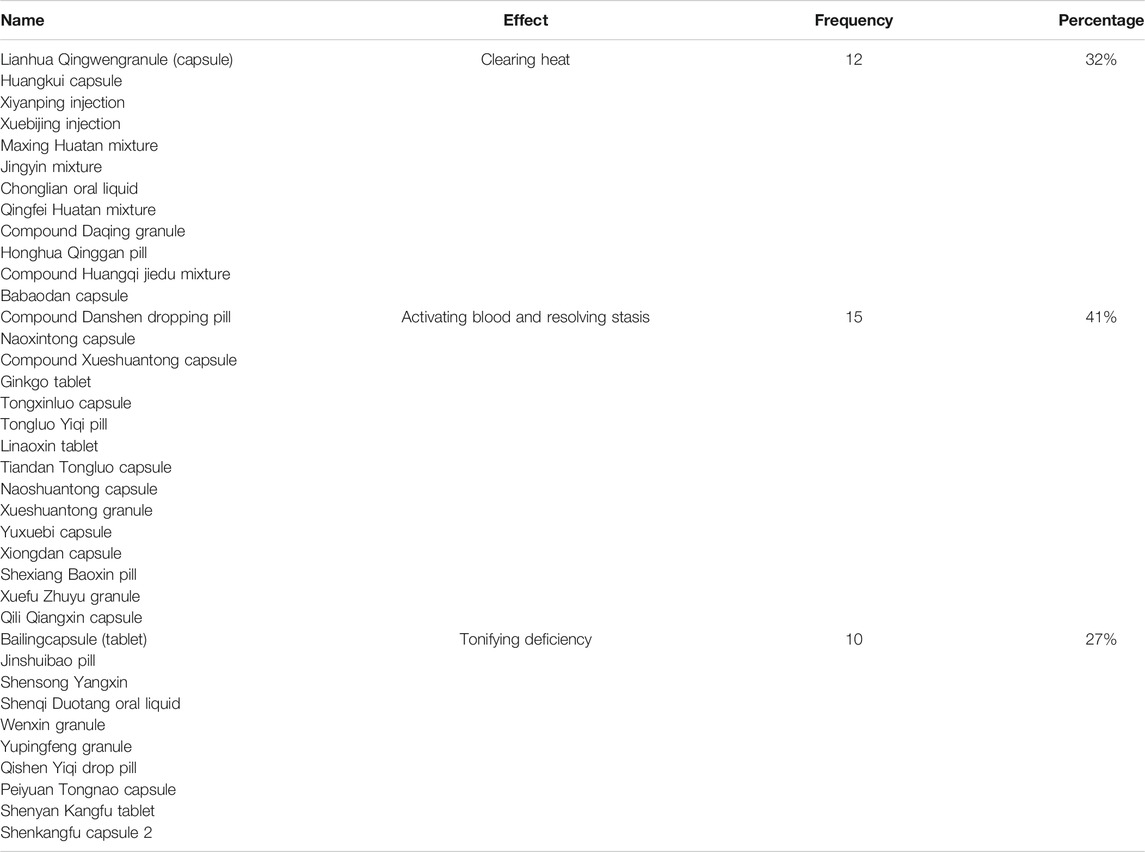
TABLE 12. Effect distribution of Chinese patent medicines in traditional Chinese medicine hospitals.
Data Statistics for March 01–03, 2020
National Data Statistics
The data of 24 hospitals nationwide were summarized and the name of Chinese patent medicines with a frequency of more than one was obtained. Among them, the top four Chinese patent medicines are the Bailing capsule (tablet), compound Danshen dropping pill, Naoxintong capsule, Lianhua Qingwen granules (capsule). During March 01–03, medicines for tonifying deficiency, and activating blood and resolving stasis became the main categories nationwide (specific data is shown in Supplementary Table S27).
Data Statistics of Different Risk Areas
The usage frequency of Chinese patent medicine in high-risk and low-risk areas was counted (specific data is shown in Supplementary Tables S16, S17), respectively, and the distribution regularities of efficacy were analyzed (Table 15, 16). Comparing with the high-risk area and low-risk area, the utilization rate of heat-clearing medicines (33%) in the high-risk areas was about twice as much as that in the low-risk area (12%). The results showed that there was no significant difference between the use frequency of heat-clearing medicines and non-heat-clearing medicines in the high-risk and low-risk areas (p > 0.05, Table 21).
Data Statistics of Different Regions
The usage frequency of Chinese patent medicine in the southern and northern regions was counted (specific data is shown in Supplementary Tables S18, S19), respectively, and the distribution regularities of efficacy were analyzed (Table 17, 18). It can be seen that the proportion of heat-clearing medicines in southern regions is the highest (40%). In the northern regions, the heat-clearing medicines account for the smallest proportion (20%), while activating blood and removing stasis is the category with the highest utilization rate (47%). The analysis results showed that there was no significant difference in the frequency of using heat-clearing medicines and non-heat-clearing medicines between southern and northern regions (p > 0.05, Table 21).
Data Statistics of Hospitals of Different Properties
The usage frequency of Chinese patent medicine in TCM and western medical hospitals was counted (specific data is shown in of Supplementary Tables S20, S21), respectively, and the distribution regularities of efficacy were analyzed (Table 19, 20). It can be seen that both TCM hospitals and Western medical hospitals tend to use medicines for activating blood and removing stasis, and tonifying deficiency. The results showed that there was no significant difference in the usage frequency of heat-clearing medicines and non-heat-clearing medicines between different hospitals (p > 0.05, Table 21).
Data Statistics for April 01–03, 2020
National Data Statistics
The data of 24 hospitals nationwide were summarized and the name of Chinese patent medicines with a frequency of more than one was obtained. Among them, the top four proprietary Chinese medicines are the Bailing capsule, compound Danshen dropping pill, Naoxintong capsule, Jinshuibao tablet, and Lianhua Qingwen granules (capsules) (specific data is shown in Table 40 Supplementary Table S22).
Data Statistics of Different Risk Areas
The usage frequency of Chinese patent medicine in high-risk and low-risk areas was counted (specific data is shown in Supplementary Tables S23, S24), respectively, and the distribution regularities of efficacy were analyzed (Table 22, 23). The high-risk areas in April were still dominated by heat-clearing medicines. In the low-risk areas, the medicines for activating blood and removing stasis, and tonifying deficiency have occupied the majority of the commonly used medicines, while the utilization rate of heat-clearing medicines has decreased significantly, accounting for only 5%. The analysis results showed that the usage frequency of heat-clearing medicines and non-heat-clearing medicines was significantly different between high-risk and low-risk areas (p < 0.01, Table 28).
Statistics of Different Regions
The usage frequency of Chinese patent medicine in the southern and northern regions was counted (specific data is shown in Supplementary Tables S25, S26), respectively, and the distribution regularities of efficacy were analyzed (Table 24, 25). It can be seen that Chinese patent medicines mainly used in southern China are still heat-clearing medicine, followed by the medicine for tonifying deficiency, and activating blood and removing stasis. In northern China, the main category is the medicine for activating blood and removing stasis, followed by heat-clearing medicine and medicine for tonifying deficiency. The analysis results showed that there was no significant difference in the frequency of heat-clearing medicines and non-heat-clearing medicines between the southern and northern regions (p > 0.05, Table 28).
Data Statistics of Hospitals of Different Properties
The usage frequency of Chinese patent medicine in TCM and western medical hospitals was counted (specific data is shown in Supplementary Tables S27, S28), respectively, and the distribution regularities of efficacy were analyzed (Table 26, 27). It can be seen from the comparison between TCM hospital and western medical hospital that the main treatment direction of TCM hospital is to tonify deficiency and promote circulation and remove stasis, which is in line with the characteristics of TCM for the recovery period. Although the western hospital still takes clearing heat as the primary treatment direction, the utilization rate of the other two kinds of medicine has increased, which is in agreement with the different stages of the epidemic situation in general. The analysis results showed that there was no significant difference between heat-clearing and non-heat-clearing medicines between two different types of hospitals (p > 0.05, Table 28).
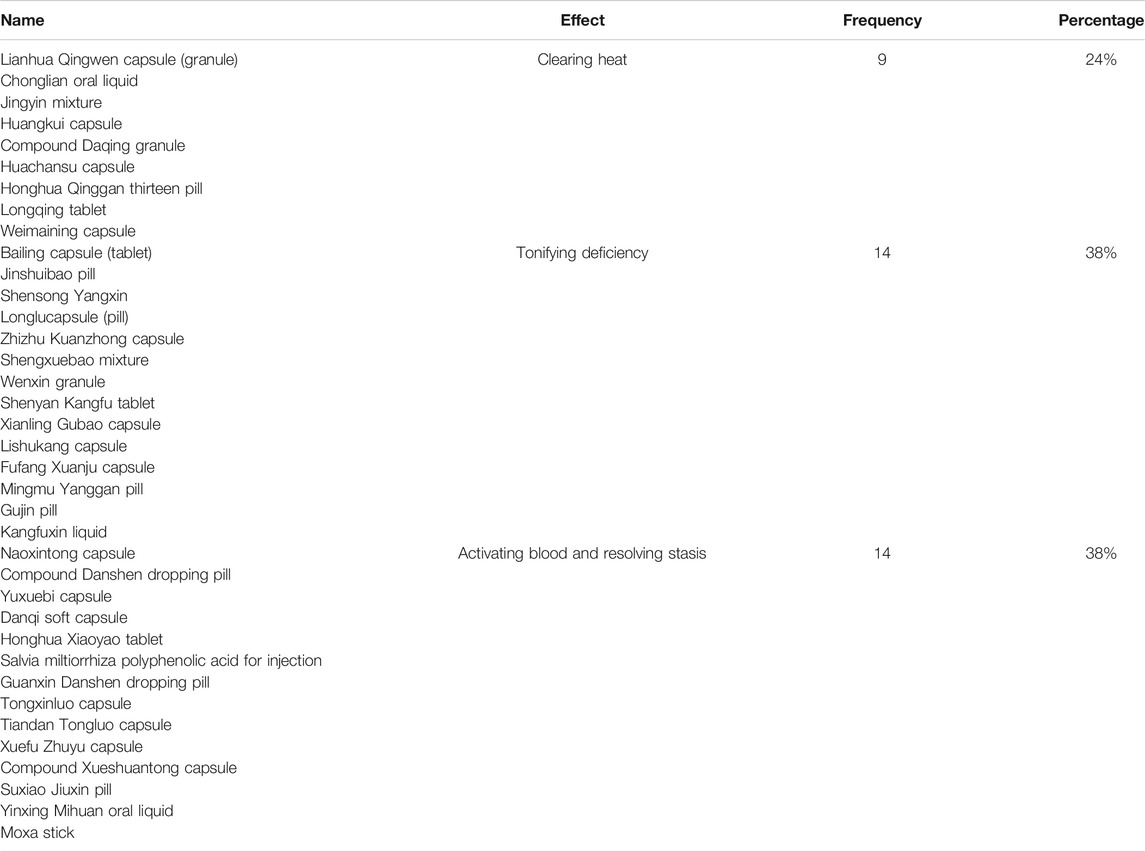
TABLE 26. Effect distribution of Chinese patent medicines in traditional Chinese medicine hospitals.
Discussion
According to the data and analysis results of this study, it is considered that the analysis method (χ2 test) matches the type of data and research purpose (significant difference), and more scientific and reasonable explanations can be obtained through the analysis results.
Because the TCMs for prevention and treatment of COVID-19 are mainly heat-clearing medicines, so the analysis focuses on the difference between the use of heat-clearing and non-heat-clearing medicines. Synthesizing the above statistical results, it turned out that in January, the utilization rate of heat-clearing and non-heat-clearing medicine in high and low-risk areas was significantly different (p < 0.01). In February, the north and south region were significantly different (p < 0.05), and in April, the high and low-risk area was significantly different (p < 0.01). According to the analysis, at the end of January, COVID-19 was just in the initial phase, and there was no effective prescription or decoction. Therefore, Chinese patent medicine became the main force to resist COVID-19 in high-risk areas. At the same time, the number of confirmed cases in low-risk areas has not yet risen to a severe level, so the Chinese patent medicines were not widely used. Consequently, different risk areas became the main factors affecting drug use in January. In mid-February, the number of confirmed cases nationwide peaked, and local treatment programmes began to be rolled out in each region, making it a major influence on drug use in February. In March, the epidemic situation was in a stage of significant decline, TCM has explored more mature and diversified treatment schemes, and the participation rate of Chinese patent medicines dropped. Hence, there was no significant difference among the three factors. In April, the epidemic situation was basically under control. At that time, the low-risk areas relaxed their vigilance, making the usage rate of heat-clearing medicine into the lowest point, so there was a significant difference with high-risk areas.
As shown in Figure 3, from January to April, the usage rate of heat-clearing medicines was the highest during January 20–22, when COVID-19 was just beginning to spread, while the remarkably decreased usage rates are shown in other three time points. Moreover, the usage rate of heat-clearing medicines in different risk areas, regions, and hospitals of different properties also showed the above trend, but did not show a significant correlation with the COVID-19 epidemic (p > 0.05, Table 29). On account of the above results, the following considerations are made: 1) The Chinese patent medicines mainly participate in the early stage of the COVID-19, and the participation decreases in the outbreak stage, the decline stage, and the end-stage. 2) It is speculated that there were many blind purchases or use of Chinese patent medicines in the early stage, due to the public’s lack of understanding of COVID-19, panic mentality, and the pharmacy’s lax control over the use of heat-clearing medicines. 3) In this survey, the collected time points are limited with a short period, which cannot fully reflect the specific change rule of utilization rate over time. More evidence is needed to verify the above speculations further. 4) In correlation analysis, the sample size is too small to fully explain the relationship between the epidemic situation and three factors.
Conclusion
At present, studies on Chinese patent medicines for COVID-19 mostly focus on therapeutic regimens, clinical observation, and pharmacological studies. There is almost no analysis of the overall use of Chinese patent medicines during COVID-19. This study was conducted to investigate the use of Chinese patent medicines in 24 third-grade class-A hospitals in 14 provinces or cities of China during the epidemic of COVID-19. And we have found that Chinese patent medicines play a role in the fight against COVID-19 and heat-clearing medicines were the most used weapons. Moreover, the risk area is the main influencing factor for the use of Chinese patent medicines.
Heat-clearing medicine, especially with the antiviral effect, has a high utilization rate during January-April, so it is considered that Chinese patent medicine has a certain degree of participation in the fight against COVID-19. On the whole, previous studies paid more attention to the medication difference of three-concerned therapy of “individual concerned therapy, environment concerned therapy, climate concerned therapy,” and this study confirmed that the use of Chinese patent medicine was different in the regions to some extent. Furthermore, two other factors were considered in the investigation, namely, hospitals of different properties and different risk regions. It was found that different risk regions were the main factor affecting the utilization rate of heat-clearing drugs.
On January 31, 2020, COVID-19 was listed as a public health emergency of international concern by the World Health Organization, which seriously endangered people’s health and public safety, and became one of the major epidemics after SARS in 2003 (Zhong et al., 2003; Cucinotta and Vanelli, 2020). So far, there is still no effective antiviral treatment for COVID-19 (Shereen et al., 2020; Stawicki et al., 2020). Symptomatic support therapy and comprehensive interventions are mainly used in clinical practice (Wu et al., 2020b).
Since the outbreak of COVID-19 (Wu et al., 2020b), TCM has been able to get involved in the whole process of treatment and achieved remarkable results (Li et al., 2020). TCM integrates its treatment principles (syndrome differentiation and three-concerned therapy of “individual concerned therapy, environment concerned therapy, climate concerned therapy”) (Wu et al., 2020a) with the different stages of COVID-19. Clinical studies (Liu et al., 2020; Zhang et al., 2020a) showed that TCM could improve the symptoms, shorten the course of treatment, and prevent conversion to the severe state for ordinary patients. For severe and critical patients, TCM can reduce pulmonary exudation, control inflammatory overreaction, improve oxygenation level, stabilize blood oxygen saturation, and reduce the use of hormones and antibiotics to prevent the deterioration of the disease. For convalescent patients, the rehabilitation process can be promoted by TCM. Meanwhile, patients with COVID-19 also include the elderly, children, pregnant women, and those with basic diseases, whose medications have also been considered in clinical treatment. Besides, the syndrome characteristics of COVID-19 in different regions are “the same but different.” Although the common characteristic is “wet,” different regions have diverse pathogenesis due to the environmental aspect (Ma et al., 2020; Shi et al., 2020) and other factors. Therefore, multiple TCM medication plans have been introduced in different regions in China. Moreover, many studies (Bashir et al., 2020; Chen et al., 2020; Tosepu et al., 2020) have shown that climate change can affect the spread of the COVID-19 and the pathogenesis of the human body, so the use of TCM should also take into account the influence of seasonal variations. Besides, some studies have suggested that the transmission of COVID-19 is related to air pollution and population density (Kadi and Khelfaoui, 2020; Martelletti and Martelletti, 2020). The cure rate and prognosis of COVID-19 are closely related to the underlying diseases such as cancer, hypertension, body mass index, and diabetes (Malik et al., 2020; Meng et al., 2020; Pugliese et al., 2020). These views have a high value of in-depth thinking and provide more direction for the research of drug use for COVID-19.
The TCMs involved in anti-epidemic include TCM decoction and Chinese patent medicine. It is well known that TCM decoction has played a great role in against the COVID-19 in China, while there are few reports and studies on Chinese patent medicine. The seventh Trial Version of the Guidelines for the Diagnosis and Treatment of COVID-19 by the National Health Commission of China recommends four oral Chinese patent medicines [Huoxiang Zhengqi capsule (pill, oral liquid, water), Jinhua Qinggan granule, Lianhua Qingwen capsule (granule), Shufeng Jiedu capsule (granule)] and eight TCM injections [(Xiyanping injection, Tanreqing injection, Xuebijing injection, Reduning injection, Xingnaojing injection, Shengmai injection, Shenfu injection, Shenmai injection)] respectively during the medical observation and clinical treatment period. According to some Chinese experts consensus and clinical experience, the intervention with Chinese patent medicine during medical observation can cut off the development of the disease in advance (Bao et al., 2020; Jin et al., 2020). Chinese patent medicine mainly plays two roles: on the one hand, it can provide symptomatic treatment; on the other hand, it can help strengthen immunity to resist the attack of the virus, so as to “prevent infection before illness” and “prevent transmission after illness” (Xiong et al., 2020). Clinical observation showed that (Duan et al., 2020; Yao et al., 2020), Jinhua Qinggan granules can significantly relieve the clinical symptoms of fever, cough, fatigue, and expectoration in mild COVID-19 patients. Lianhua Qingwen granules can significantly improve fever, cough, expectoration, and anhelation in COVID-19 patients, whose antifebrile time and the time of viral nucleic acid test turning negative were comparable to oseltamivir. Pharmacology experiments found that (Wang et al., 2020a) Chinese patent medicine showed a direct antiviral effect, could improve the inflammation caused by a virus infection, and have the function of the two-way adjusting the immune system. Furthermore, it can also impede or delay cytokine storm through the immunoregulation and anti-inflammatory action (Luo et al., 2020) and can suppress the occurrence or development of pulmonary fibrosis effectively. Huoxiang Zhengqi relieves symptoms through anti-inflammatory effects. Lianhua Qingwen defends the lung from COVID-19 by inhibiting pro-inflammatory cytokine production. Shufeng Jiedu plays roles in the COVID-19 through multiple targets and inflammatory signaling pathways. Xuebijing injection can reduce multiple organ damage by anti-inflammatory and improving immune function (Tong et al., 2020).
However, there are some limitations in this study. Firstly, the investigation only counted the names of the top three Chinese patent medicines used by hospitals, ignoring the specific application amount, which made it challenging to conduct more in-depth statistical analysis. Secondly, the distribution of the 24 hospitals investigated in this study is uneven across the country, which may affect the rigor of analysis results although the frequency was weighted in the analysis. Finally, the limited time points with a short time quantum cannot fully reflect the specific change rules of utilization rate over time, which need further in-depth discussion.
Data Availability Statement
The raw data supporting the conclusions of this article will be made available by the authors, without undue reservation, to any qualified researcher.
Author Contributions
YH, LL, XZ, XK, BZ, WY, YL, DD, MZ, YZ, LL, XW (16th author), JW, XL, HN, XW (20th author), HuW, FL, HoW, HuW, YL, LL, WZ, MY collected the hospital data. NZ drafted the manuscript. NS, SL, GL helped the data analysis. YW, HZ, YW revised the final manuscript.
Funding
This study was funded by the National Key R&D Program of China (NO. 2019YFC1712000); Subject: Development of international standards for services in clinical pharmaceutical affairs of Chinese Patent Medicine and dispensing education (NO. 2019YFC1712002).
Conflict of Interest
The authors declare that the research was conducted in the absence of any commercial or financial relationships that could be construed as a potential conflict of interest.
Supplementary Material
The Supplementary Material for this article can be found online at: https://www.frontiersin.org/articles/10.3389/fphar.2020.574562/full#supplementary-material
References
Bao, G., Liao, Y., Wu, M., and Sun, L. (2020). Prescription analysis and clinical study on the modern Chinese patent medicine in the treatment of early novel coronavirus pneumonia. Clin. J. Tradit. Chin Med. 32 (06),1009-1012. 1–8.
Bashir, M. F., Ma, B., Bilal, , Bilal, B., Komal, B., Bashir, M. A., et al. (2020). Correlation between climate indicators and COVID-19 pandemic in New York, USA. Sci. Total Environ. 728, 138835. doi:10.1016/j.scitotenv.2020.138835
Chen, B., Liang, H., Yuan, X., Hu, Y., Xu, M., Zhao, Y., et al. (2020). Roles of meteorological conditions in COVID-19 transmission on a worldwide scale. medRxiv. doi:10.1101/2020.03.16.20037168
Chen, L., Ge, G., Yan, R., Wei , Fu, Mingyue, Zheng, Yongfang, Z., et al. (2020). Application and research progress of traditional Chinese medicine in prevention and treatment of COVID-19. J. Shanghai Univ. Tradit. Chin. Med. 34 (3), 1–8. doi:10.16306/j.1008-861x.2020.03.001.
Cucinotta, D., and Vanelli, M. (2020). WHO declares COVID-19 a pandemic. Acta Bio-Med. 91 (1), 157–160. doi:10.23750/abm.v91i1.9397.
Duan, C., Xia, W., Zheng, C., Guobing, S., Zhengliang, L., Qinglin, L., et al. (2020). Clinical observation of Jinhua Qinggan granule in the treatment of novel coronavirus pneumonia. J. Tradit. Chin. Med. 1–5.
Jin, R., Kong, L., and Yan, D., (2020). Pharmaceutical consensus on early Chinese patent medicine intervention for novel coronavirus pneumonia (Beijing). Chin. J. Hosp. Pharm. 40 (08), 837-846. doi:10.13286/j.1001-5213.2020.08.01.
Kadi, N., and Khelfaoui, M. (2020). Population density, a factor in the spread of COVID-19 in Algeria: statistic study. Bull. Natl. Res. Cent. 44, 138. doi:10.1186/s42269-020-00393-x
Li, Q., Wang, H., Li, X., Zheng, Y., Wei, Y., Zhang, P., et al. (2020). The role played by traditional Chinese medicine in preventing and treating COVID-19 in China. Front. Med. 14 (5), 681-688. doi:10.1007/s11684-020-0801-x
Liu, Q., Xia, W., An, C., Xucheng, L., Yuguang, W., Qing, M., et al. (2020). Reflections on the effect of integrated Chinese and western medicine on novel coronavirus pneumonia. J. Tradit. Chin. Med. 61 (6), 463–464. doi:10.13288/j.11-2166/r.2020.06.002.
Luo, H., Gao, Y., Zou, J., Zhang, S., Chen, H., Liu, Q., et al. (2020). Reflections on treatment of COVID-19 with traditional Chinese medicine. Chin. Med. 15, 94. doi:10.1186/s13020-020-00375-1
Ma, Y., Zhao, Y., Liu, J., He, X., Wang, B., Fu, S., et al. (2020). Effects of temperature variation and humidity on the mortality of COVID-19 in Wuhan. Sci. Total Environ. 724, 138226. doi:10.1016/j.scitotenv.2020.138226
Malik, V. S., Ravindra, K., Attri, S. V., Bhadada, S. K., and Singh, M. (2020). Higher body mass index is an important risk factor in COVID-19 patients: a systematic review and meta-analysis. Environ. Sci. Pollut. Res. 27 (33), 42115-42123. doi:10.1007/s11356-020-10132-4
Martelletti, L., and Martelletti, P. (2020). Air pollution and the novel COVID-19 disease: a putative disease risk factor. SN Compr. Clin. Med. 2, 383–387. doi:10.1007/s42399-020-00274-4
Meng, Y., Lu, W., Guo, E., Liu, J., Yang, B., Wu, P., et al. (2020). Cancer history is an independent risk factor for mortality in hospitalized COVID-19 patients: a propensity score-matched analysis. J. Hematol. Oncol. 13, 75. doi:10.1186/s13045-020-00907-0
National Health Commission, National Administration of Traditional Chinese Medicine (2020). Diagnosis and treatment regimen of novel coronavirus pneumonia (version seven) [EB/OL]. Available at: http://www.nhc.gov.cn/yzygj/s7653p/202003/46c9294a7dfe4cef80dc7f5912eb1989.shtml(Accessed March 10, 2020).
Pugliese, G., Vitale, M., Resi, V., and Orsi, E. (2020). Is diabetes mellitus a risk factor for COronaVIrus Disease 19 (COVID-19)? Acta Diabetolo. 57, 1275–1285. doi:10.1007/s00592-020-01586-6
Sheng, X. (2008). The status of the Huaihe River in the boundary between the north and the south of ancient China. J. Anc. Civiliz. (1), 55–64+112–113. doi:10.16758/j.cnki.1004-9371.2008.01.009
Shereen, M. A., Khan, S., Kazmi, A., Bashir, N., and Siddique, R., (2020). COVID-19 infection: origin, transmission, and characteristics of human coronaviruses. J. Adv. Res. 24, 91–98. doi:10.1016/j.jare.2020.03.005
Shi, P., Dong, Y., Yan, H., Li, X., Zhao, C., Liu, W., et al. (2020). The impact of temperature and absolute humidity on the coronavirus disease 2019 (COVID-19) outbreak-evidence from China. medRxiv. doi:10.1101/2020.03.22.20038919
Stawicki, S., Jeanmonod, R., Miller, A., Paladino, L., Gaieski, D., Yaffee, A., et al. (2020). The 2019-2020 novel coronavirus (severe acute respiratory syndrome coronavirus 2) pandemic: a joint American College of Academic International Medicine-World Academic Council of emergency medicine multidisciplinary COVID-19 working group consensus paper. J. Global Infect. Dis. 12 (2), 47–93. doi:10.4103/jgid.jgid_86_20
Sun, X., Xu, C., Sun, W., and Pan, B. (2020). Understanding of COVID‐19 based on current evidence. J. Med. Virol. 92 (6), 548–551. doi:10.1002/jmv.25722
Tong, T., Wu, Q. Y, Wei, J., Shen, A. Z., and Liu, J. (2020). The potential insights of Traditional Chinese Medicine on treatment of COVID-19. Chin. Med. 15, 51. doi:10.1186/s13020-020-00326-w
Tosepu, R., Gunawan, J., Effendy, D. S., Ahmad, L. O. A. I., Lestari, H., Bahar, H., Asfian, P., et al. (2020). Correlation between weather and COVID-19 pandemic in Jakarta, Indonesia. Sci. Total Environ. 725, 138436. doi:10.1016/j.scitotenv.2020.138436
Wang, J., Tang, F., and Wei, F. (2020). Updated understanding of the outbreak of 2019 novel coronavirus (2019‐nCoV) in Wuhan, China. J. Med. Virol. 92 (4), 441–447. doi:10.1002/jmv.25689
Wang, T., Han, L., Wang, Y., Miao, L., Yang, J., Zhang, J. H., et al. (2020a). Advances in the treatment of virus pneumonia with Chinese patent medicine.China J. Chin. Mater. Med. 45 (7), 1509–1514.
Wang, H., Jin, X., Pang, B., Zheng, W.-K., Yang, F.-W., Pang, W.-T., et al. (2020). Analysis on clinical research protocols of Traditional Chinese Medicine intervention on COVID-19. China J. Chin. Mater. Med. 45 (6), 1232–1241. doi:10.19540/j.cnki.cjcmm.20200220.501
Wang, T., Han, L., Wang, Y., Miao, L., Yang, J., Zhang, J.-H., et al. (2020b). Recent advances in treatment of viral pneumonia using Chinese patent medicine. Chin. J. Chin. Mat. Med. 45 (7), 1509–1514. doi:10.19540/j.cnki.cjcmm.20200312.502
World Health Organization (2020). Rolling updates on coronavirus disease (COVID-19)[EB/OL]. Available at: https://www.who.int/emergencies/diseases/novel-coronavirus-2019/events-as-they-happen (Accessed May 1, 2020).
Wu, Y., Fu, X., Zhang, X., and Zhang, Z. (2020a). Discussion on the distinction of different traditional Chinese medicine schemes of Novel coronavirus pneumonia based on the principle of “three-concerned therapy”. Chin. J. Exper. Tradit. Med. Form. 26 (13), 17–24. doi:10.13422/j.cnki.syfjx.20201326.
Wu, Y., Lu, Z., Xiao, Y., et al. (2020b). Systematic evaluation of integrated Chinese and western medicine in the treatment of novel coronavirus pneumonia. Shanghai J. Tradit. Chin. Med. 54 (6), 29–36. doi:10.16305/j.1007-1334.2020.06.093.
Xiong, W., Ran, J., Xie, X., Xia, Y., Lan, B., Wang, M., et al. (2020). Pharmacological effect and clinical application of Chinese patent medicine in the treatment of Novel coronavirus pneumonia. Her. Med. 39 (4), 465–476. doi:10.3870/j.issn.1004-0781.2020.04.008
Yao, K., Liu, M., Li, X., Jihan, H., Hongbin, C., et al. (2020). Retrospective clinical analysis of Lianhua Qingwen in the treatment of novel coronavirus pneumonia. Chin. J. Experi. Tradit. Med. Form. 26 (11), 8–12. doi:10.13422/j.cnki.syfjx.20201099.
Yuan, W., Hu, Y., Tang, J., Hao, Y., Junhua, Z., Zhongqi, Y., et al. (2020). Some thoughts on the clinical study of traditional Chinese medicine for COVID-19. Shanghai J. Tradit. Chin. Med. 54 (4), 1–5. doi:10.16305/j.1007-1334.2020.04.099.
Zhang, B. (2020). What role does traditional Chinese medicine play in the prevention and treatment of COVID-19. Study Times.
Zhang, B., Liu, Q., Zhang, J., Fengwen, Y., Ming, H., et al. (2020a). Play the role of integrated Chinese and western medicine in epidemic prevention and control. Tianjin J. Tradit. Chin. Med. 37 (3), 241. doi:10.11656/j.issn.1672-1519.2020.03.01
Zhang, B., Zhang, J.-T., Sa, R.-N., Zhang, X.-M., and Lin, Z.-J. (2020b). The clinical benefits of Chinese patent medicines against COVID-19 based on current evidence. Pharmacol. Res. 157, 104882. doi:10.1016/j.phrs.2020.104882
Keywords: Chinese patent medicine, COVID-19, application regularity, correlative factor, retrospective analysis
Citation: Zhang N, Shi N, Li S, Liu G, Han Y, Liu L, Zhang X, Kong X, Zhang B, Yuan W, Liu Y, Deng D, Zheng M, Zhang Y, Li L, Wang X, Wu J, Lin X, Nian H, Wu X, Wang H, Liu F, Wang H, Wang H, Liu Y, Liu L, Zeng W, Yang M, Wang Y, Zhai H and Wang Y (2020) A Retrospective Study on the Use of Chinese Patent Medicine in 24 Medical Institutions for COVID-19 in China. Front. Pharmacol. 11:574562. doi: 10.3389/fphar.2020.574562
Received: 03 July 2020; Accepted: 30 September 2020;
Published: 30 November 2020.
Edited by:
Rafael Maldonado, Pompeu Fabra University, SpainReviewed by:
Luis Laranjeira, Eli Lilly, PortugalMuhammad Usman, University of Veterinary and Animal Sciences, Pakistan
Copyright © 2020 Zhang, Shi, Li, Liu, Han, Liu, Zhang, Kong, Zhang, Yuan, Liu, Deng, Zheng, Zhang, Li, Wang, Wu, Lin, Nian, Wu, Wang, Liu, Wang, Wang, Liu, Liu, Zeng, Yang, Wang, Zhai and Wang. This is an open-access article distributed under the terms of the Creative Commons Attribution License (CC BY). The use, distribution or reproduction in other forums is permitted, provided the original author(s) and the copyright owner(s) are credited and that the original publication in this journal is cited, in accordance with accepted academic practice. No use, distribution or reproduction is permitted which does not comply with these terms.
*Correspondence: Yanping Wang, wangyanping4816@163.com Huaqiang Zhai, zhaihq@bucm.edu.cn
 Nan Zhang
Nan Zhang Nannan Shi2
Nannan Shi2 Xiaolan Lin
Xiaolan Lin Hua Nian
Hua Nian Hua Wang
Hua Wang Li Liu
Li Liu